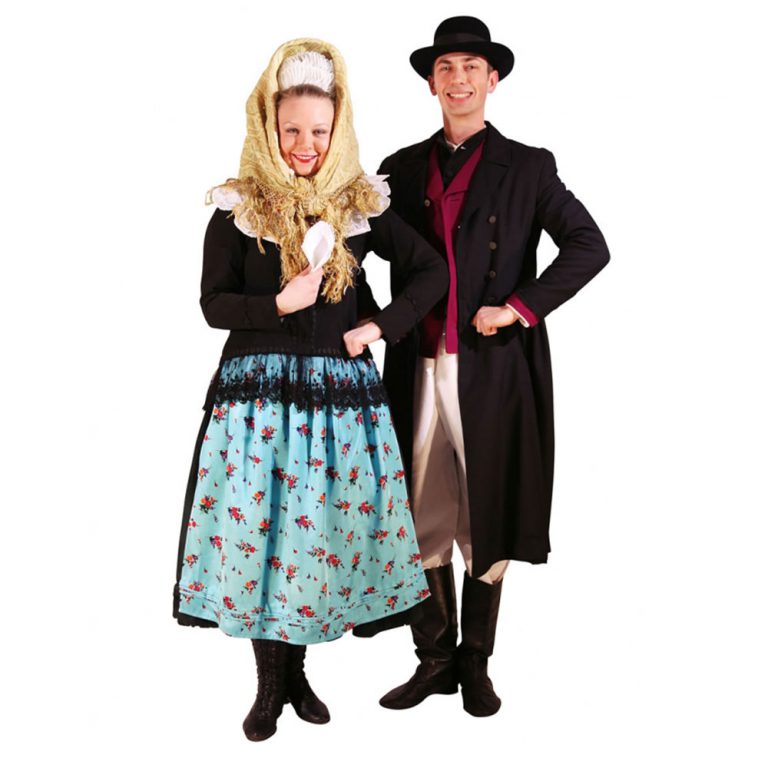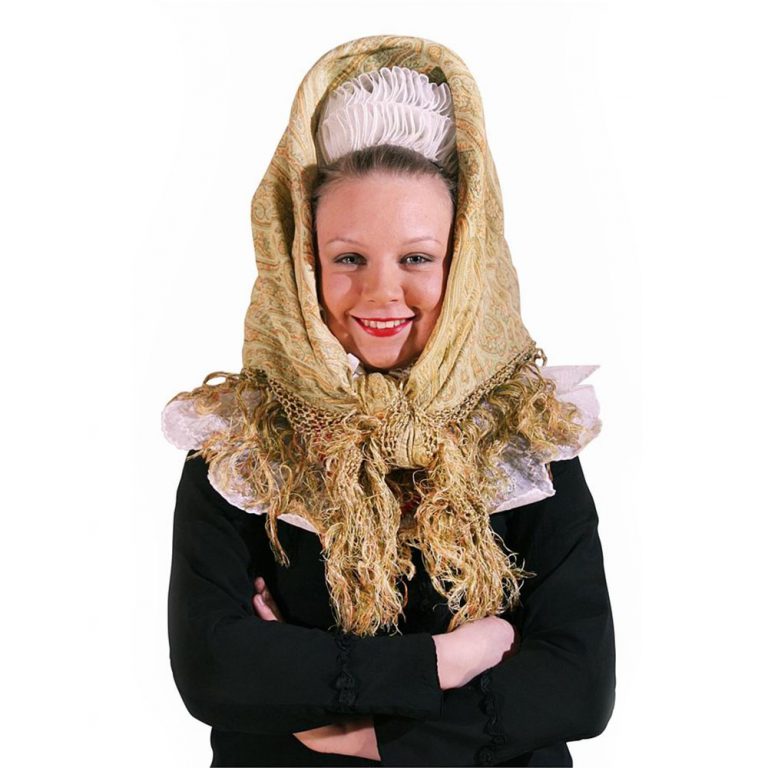Traditional costume from the Biskupizna region

Biskupizna is one of the regions in southern Wielkopolska. The are of Biskupizna is an ethnographic community of 12 villages located in the vicinity of Krobia. These villages were in the past the property of Poznań bishops, hence the name. As a result of unique living and farming conditions of the area, it quickly gave rise to a model of modern and diligent farmer. The outfit of Biskupizna equal the women and men was very differentiated. It appeared in few kinds, depended on the age, the civil status and the holidays.
Outfit of a maid
A festive outfit of young girls consisted of a few fixed elements. It included the following articles of underwear: a white linen shirt with long sleeves finished with cuffs and a lace around the hand and a white linen spódnik, decorated with a frill, starched and pressed stiff. A colourful spódnik with a bodice, mostly blue, celadon, yellow or orange, was put on top of the underwear. In this case the term spódnik referred to a sleeveless dress sewn from silk or satin reaching down to mid-calf; it was fastened in the upper part with hooks and eyes. An important feature of the dress were about 130 pleats around the waist and the bottom decorated with 4-6 tucks. As an apron was an indispensable element of the festive outfit worn on the dress, girls and women possessed at least several of them. They were sewn from silk or satin in different colours and were “painted in flowers”. After the Second World War, proboably for lack of better materials, women started wearing aprons sewn from white linen decorated with colourful hand-made embroidery, mostly with motifs such as flowers, twigs and leaves. Girls wore this outfit with white silk or woollen stockings on the garters made of silk or rubber bands and black high-top leather boots. Th headgear in the form of a tulle bonnet was an impressive decoration of the young maid’s outfit. It consisted of a round bottom and two straps of tulle arranged in a concertina which was called “karbowana pod śłońce”. This basic part of the bonnet was known as a kopka, and there was another part, known as an okap, attached to it. The okap was decoratively draped in high waves giving an impression of wings. The bonnet with such a sophiticated design was decorated with hand-made embroidery with a white cotton thread. The typical motifs were zigzags, geometric shapes, dots, and floral patterns. The boonnets wit hthe okap were worn almost on top of the head, tied under the chi with the bandy, or plain white ribbons whose ends, after being tied in a bowknot in the shape of a butterfly, were pinned on the sides of the bonnet. Red genuine coral beads supplemented the festive outfit.
Outfit of married woman
A festive outfit of married women, regardless of their age, was sewn from good quality materials of which were colourful fabrics, usually put together for contrast. The underwear, which was no different fro mshirts and white petticoats worn by maids, was covered with a skirt also called a spódnik, sewn frim a 4-metre lenght of cloth, wool or silk in verious colours, preferably green, brown or amaranthine. The length of the skirts was of certain importance: elderly women wore ankle-length ones and only young married women could tak the liberty to wear mid=calf skirts, exposing their stockings. The skirt also had characteristic pleats visible in the front and in the back, and also tucks a typical feature of the folk dress from Biskupizna, placed near the bottom part of the spódnik. The edge of the skirt was trimmed with a brush tape called borta. The festive outfit was worn with a matchig apron. It could be silk or satin apron with a floral pattern or voile, betiste or other transparent material outfit decorated with a lace, insertions and frills. Another important element of the above outfit was a kabat, known also as a kaftanik or a jaczka. It is an example of the part of the outfit which appeared in the folk dress as a result of external, urban or foreign influence. There were several kind of jaczka in the wardrobe of the Biskupizna women, worn depending on the circumstances. Such an outfit was worn with high-top mid-calf black leather boots. Wearing a bonnet known as klapica with the festive outfit was an exclusive privilege o a married women. It was a tulle bonnet decorated with beautiful embroidery and wrapped around with the jedwabnica. From 1919 to 1939 the festive outfit of married women was worn with one more kind of the headgear. After puttin on a part of the bonnet called a kopka women wrapped it around with a big shawl in Turkish or French patterns. The festive outfit was complete with a tulle, a hand embroidered kryzik and genuine coral beads.
Outfit of a man
Men’s folk dress from Biskupizna also came in a few varieties. A young man, a bachelor who participated in important but joyful celebrations and holidays dressed in accordance with traditional requirements. Thus put on a white shirt with a detachable collar, a black vest, white trousers, and amaranthine jaka. The jaka was mid-length and it ended under the waist, it was buttoned in the front with 4 buttons and the characteristic amaranthine colour was a sign of the colour of the bishops. With such an outfit the bachelor wore black high-top shoes called oficerki and the black hat with a small brim and the crown surrounded with a black tape or a ribbon. The element which completed the men’s outfit was a whip decorated with a white scarf. It was made from roe deer’s foot and brainded leather straps. Besides those basic elements, a farmer and a married man also wore a black usset coat known as a wołoszka in order to emphasise his dignity and position. It was sewn from black cloth of good quality. Itwas close-fitting in the upper part and had a turndown collar with lapels. A characteristic feature of this russet coat were about 50 pleats arranged in the back and on the sides of the waist.















